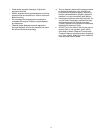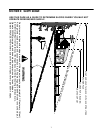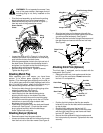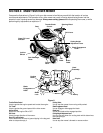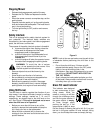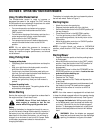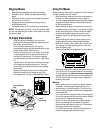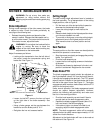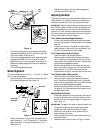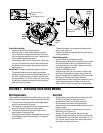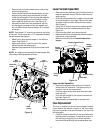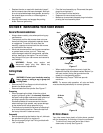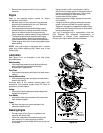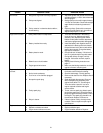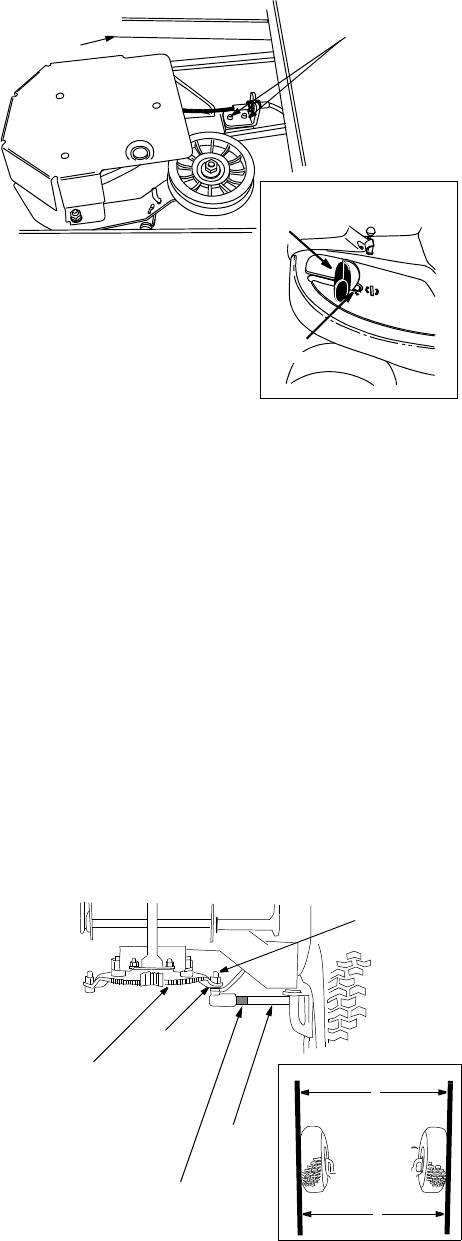
15
Figure 12
• If the belt is slipping when you depress the blade
engagement pedal about 3/4”, loosen the two hex
nuts on the cable. See Figure 12.
• If the belt is engaging sooner than when the blade
engagement pedal is 3/4” from the PTO switch,
tighten both hex nuts on the cable. See Figure 12.
• Repeat the blade engagement test and readjust if
necessary.
• Pivot the hood assembly back.
Wheel Alignment
The front wheels should toe-in 0 - 1/16 inch. To adjust
toe-in, follow these steps:
• Remove the 3/8’’ hex nut which holds the ball joint
to the steering segment. See Figure 13.
Figure 13
• Adjust the ball joint in or out until the wheels toe-in
approximately 0 - 1/16" (Dimension ‘‘B’’ should be
approximately 0-1/16" less than dimension ‘‘A’’).
See Figure 13.
• Replace the ball joint into the steering segment,
and replace the 3/8’’ hex nut.
Adjusting the Deck
There are three tests for checking deck levelling on the
riding mower. The results of each test will determine
what kind of levelling, if at all, the equipment needs.
IMPORTANT:
Perform adjustments to the deck on a flat,
level surface. Before continuing with deck adjustment,
check air pressure in all four tires. Recommended air
pressure is 12 psi. Please note that the valve stems on
this riding mower are on the inside of the front wheels
and on the outside of the rear wheels.
Test 1: Checking Rear Deck Height Adjustment
• Lift the hood assembly and remove grass catcher
from the riding mower. Place the deck in the highest
position.
• Inspect rear of deck. If the deck is contacting the
cable bracket on the front of the transmission, you
will have to adjust the rear deck height.
Test 2: Checking Front to Rear Levelling
• Place the deck in the highest position.
• Wearing a pair of heavy work gloves to prevent
injury, rotate the cutting blade so that it is pointed
front to back and parallel to the rider. Depress and
lock the deck engagement pedal.
• Measure the distance from the front and the rear
tips of the blade to the ground.The front should be
approximately 1/4” to 3/8” lower than the rear.
• If the distance is higher, level the deck front to rear.
Test 3: Checking Side to Side Levelling
• Place the deck in the highest position.
• Wearing a pair of heavy work gloves to prevent
injury, rotate the cutting blade so that it is pointed
side to side and perpendicular to the rider. Depress
and lock the deck engagement pedal.
• Measure the distance from the tips of the blade to
the ground. If the two distances are unequal, level
the deck side to side.
Adjusting Rear Deck Height
• Completely loosen, but do not remove, the top hex
nut out of the three hex nuts that hold the hex bolt
and the ferrule on the deck hanger link assembly.
See Figure 14 .
IMPORTANT:
Do not try to loosen or tighten bottom nut.
• Thread the middle nut as far down as possible.
• Locate the lower links at the rear of the deck.
Working on one side at a time, disconnect the
helper springs from them.
• Remove each lower link by removing both hair pin
clip and washers.
• Reattach lower links as shown in Figure 14 inset.
Deck
Hex
Nut
PTO
Switch
Blade Engagement
Pedal
Engagement
Cable
Steering
front
B
0 - 1/16’’ less than A
A
Segment
Washer
Lock
Tie
Rod
Ball
Joint
Hex Nut



